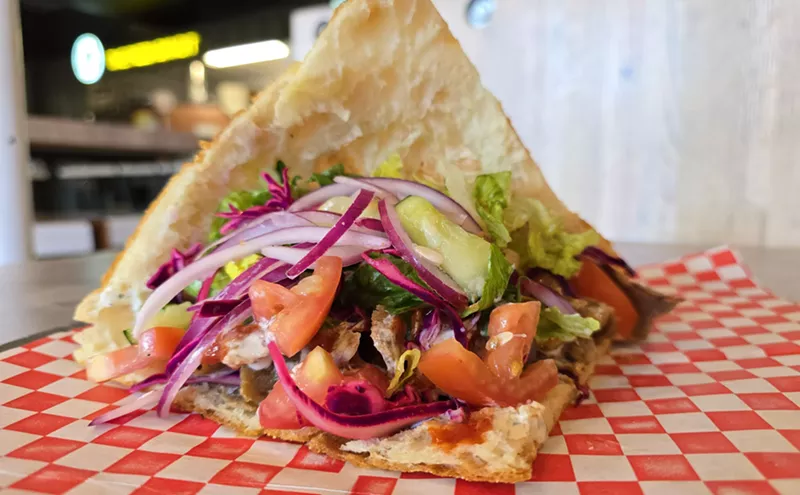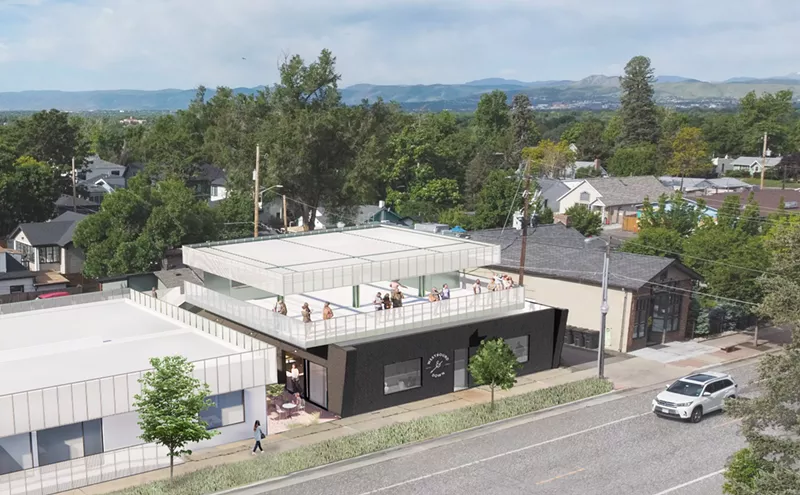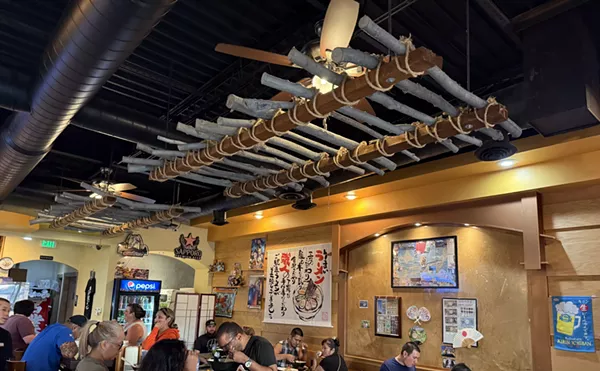Tyler and Kimberly Armstrong
Simply Pizza Food Truck
Kimberly and Tyler Armstrong own their own construction and fabrication business. But they’re also avid home cooks and tinkerers, so Tyler — who goes by Ty — got to thinking about how to combine their love of cooking and fondness for building things in order to tap into the mobile-food business. “We were watching our daughters play lacrosse, with thousands of people in the park,” he recalls, “and there was no food.”
His thinking was initially on a small scale: “I was actually going to build a couple of hot dog carts,” he explains. But he and Kimberly also wanted something that would involve recipe development and hands-on cooking, and so the idea grew into the Simply Pizza food truck, which would cruise the southern suburbs (they live in Parker). After working on their creation for more than two years, the Armstrongs launched a monster food truck they affectionately call Kate in March, when they sold their first pizzas.
Kate is not your standard food truck; she’s a 2002 International 4300 flatbed truck with a DT466 diesel engine (translation: It’s a really big engine). And rather than a cramped, van-sized galley, the workspace was built inside a twenty-foot transatlantic shipping container, allowing the Armstrongs and their two daughters to make and serve pizzas with no jostling for room.
The shipping container is barely recognizable from its original state. Ty cut out a portion of the floor to drop the workspace down closer to street level, so customers are almost eye-to-eye with the Armstrongs when placing orders, and he also cut a seven-by-ten-foot door in the side, with a hinged window that opens up to become an overhead canopy and an order counter that swings open for loading supplies. Additional windows provide a full view of the kitchen — a very intentional part of the design, because Ty wants customers to see the pizza oven in action. That oven is a 6,500-pound Earthstone 160: a wood-burning refractory-dome oven made for turning out Neapolitan pies. “It’s a big, big unit,” says Ty. “In fact, it’s the largest commercially manufactured wood-burning pizza oven available.”
Kimberly did the finishing work on the oven herself, riveting and polishing a copper jacket to give it more visual appeal. The oven is equipped with natural-gas hookups to maintain heat when the truck is not being used for food service, as well as a propane backup system for keeping it hot while on the go. Although wood is the primary fuel source when Simply Pizza is open for business, it would be cost-prohibitive to have to bring the oven up to the required 800 degrees every day with wood. “It takes 600 pounds of wood to bring it up to temperature,” Ty points out. For that reason, it’s cheaper and more efficient to use gas to keep the oven at 800 degrees all the time, even when Kate is parked and taking a day off. That way, only thirty to forty pounds of oak are necessary to maintain heat during several hours of lunch and dinner service.
The Armstrongs wanted to spend as little time as possible in a commissary kitchen, so they built Simply Pizza to be a fully functioning mobile kitchen, not just a food-service truck. To power the kitchen during operational hours, Ty installed a 12.5-kilowatt generator. “I could run a house with an air-conditioner and a hot tub with that generator,” he explains. But that much power was required to run the thirty-quart Hobart dough mixer, induction cook tops for making sauce, adequate lighting, and an electric dishwasher that he plans to install later this month. (He just received approval for that from the Tri-County Health Department, whose inspectors were astonished, because they’d never dealt with a mobile food-service operation with that amount of electrical power.)
Despite the generator’s size, it’s much quieter than smaller motors used by many other food trucks; it meets strict California idle regulations and makes less noise than the food truck’s exhaust fan. All of that equipment, connected with more than 1,000 feet of electrical wiring, brings the total weight of the truck to thirteen tons, so the Armstrongs also installed a gyroscope-controlled hydraulic system that maintains a level floor, even with several people moving around inside the kitchen.
All told, Ty and Kimberly put in more than 1,500 hours and somewhere in the vicinity of $200,000 (factoring in their own labor costs) to get Simply Pizza up and running. They began construction in the summer of 2013 and finished in just over a year — then parked the truck for the fall and winter, not wanting to try for a toehold in the mobile market just as the season was winding down. Meanwhile, they worked on their recipes. Some of them, like Kimberly’s sauce, have been handed down through family members, while others required development and practice to scale up to bigger batches. Kimberly handles the recipes for everything except the dough, which is Ty’s job.
“The dough was the hardest,” he notes. “Humidity and air temperature change the moisture level.” His initial plan was to purchase a larger dough mixer, but the thirty-quart model ended up being a good decision. “I had mixer envy,” he jokes. “My friend owns several pizza restaurants with sixty-quart mixers. But the batches are too heavy, and smaller batches mean better moisture-content control.” Dough warms up from friction in the mixing process, making it more difficult to predict rising time, he points out; it’s easier to get smaller batches to the proper temperature for proofing. “The right moisture level is important so you get that nice Neapolitan char without over-burning,” he adds.
He also experimented with several varieties of flour before deciding on imported Caputo 00, the gold standard for Neapolitan pizzas. Still, he had difficulty dialing in the baking process until his commercial oven was up and running, simply because it’s so difficult to replicate the necessary temperatures in a home kitchen. “[I was] breaking pizza stones in my outdoor kettle grill at home,” he remembers. Eventually, the dome oven was delivered and he was able to set it up temporarily in his fabrication shop to continue testing.
And there were plenty of tests: An air-temperature reading inside the oven can be deceptive, he notes. Even if the thermometer registers the proper 800 degrees, if the hearthstone floor and dome of the oven aren’t up to temperature, the pizza cooks too slowly. “It should take about ninety seconds to cook a pizza,” Ty explains. Although he isn’t aiming for a completely traditional Neapolitan pie (he likes the bottom of the crust less wet than the Italian standard), he still needs the crust to cook quickly in order to get the proper ratio of chew to crunch.
The couple’s attention to detail goes beyond the engineering they put into the truck and its oven; they also want the ingredients as pure as possible. “There’s not a binder, stabilizer or preservative in any of our ingredients,” Kimberly says. “It’s the quality that makes the difference.”
The pepperoni, sausage (from Denver’s own Canino’s) and Genoa salami that top the three-meat special are all uncured meats with no sodium nitrate added. Kimberly makes her own pesto, too, roasting seasonal nuts in the big oven — pine nuts in the fall, but other types when pine-nut season is over. For her sauces, she only uses fresh herbs, not dried. The menu includes a barbecue pizza featuring pulled pork that Ty smokes for ten hours; he makes his own dry rub and sauce (and uses ingredients that are free of high-fructose corn syrup). Pizzas are topped with Grande whole-milk mozzarella, a brand the Armstrongs love because the company uses milk from its own private dairies and specializes in only a few Italian varieties of cheese.
Business has been better than they expected, even with the transitional spring weather for which Colorado is famous. The Armstrongs set up regardless of rain or snow and have managed to grab some prime spots at brewery tasting rooms by filling in when other trucks cancel; during a recent snowstorm, they sold out of food despite having six inches of ice and slush on top of the truck. They’ve also taken some off-days at new breweries, like Monday nights at Declaration Brewing in southwest Denver, knowing that every customer will help spread the word. “Naively, I didn’t realize that the more popular breweries would book out ninety days or more,” Ty admits.
But tap rooms are not the only part of their business plan. The big sales come from private events, youth sports events on weekends, and festivals throughout the metro area. Simply Pizza will be one of only two food trucks at the Cherry Creek Arts Festival in July (the other is a cupcake vendor). Lacrosse tournaments at Dick’s Sporting Goods Field have also been successful stops, and they plan to take the truck to Glenwood Springs for Strawberry Days in mid-June — and possibly even to the Taste of Colorado at Civic Center Park over Labor Day weekend.
Ty and Kimberly may be new to the pizza business, but they certainly know how to build. Kate the pizza truck is in it for the long haul — and the Armstrongs hope their pizza is, too, despite the crowded mobile-food scene. “There are over three million people in the Denver metro area,” Ty notes, “so there’s room for all of us.”

Audio By Carbonatix
[
{
"name": "GPT - Billboard - Slot Inline - Content - Labeled - No Desktop",
"component": "23668565",
"insertPoint": "2",
"requiredCountToDisplay": "2"
},{
"name": "STN Player - Float - Mobile Only ",
"component": "23853568",
"insertPoint": "2",
"requiredCountToDisplay": "2"
},{
"name": "Editor Picks",
"component": "17242653",
"insertPoint": "4",
"requiredCountToDisplay": "1"
},{
"name": "Inline Links",
"component": "18838239",
"insertPoint": "8th",
"startingPoint": 8,
"requiredCountToDisplay": "7",
"maxInsertions": 25
},{
"name": "GPT - 2x Rectangles Desktop, Tower on Mobile - Labeled",
"component": "24956856",
"insertPoint": "8th",
"startingPoint": 8,
"requiredCountToDisplay": "7",
"maxInsertions": 25
},{
"name": "Inline Links",
"component": "18838239",
"insertPoint": "8th",
"startingPoint": 12,
"requiredCountToDisplay": "11",
"maxInsertions": 25
},{
"name": "GPT - Leaderboard to Tower - Slot Auto-select - Labeled",
"component": "17676724",
"insertPoint": "8th",
"startingPoint": 12,
"requiredCountToDisplay": "11",
"maxInsertions": 25
}
]











